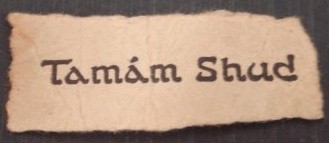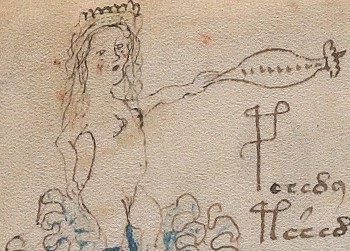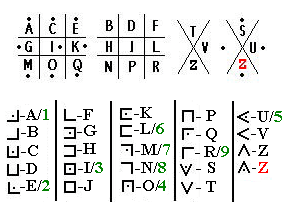Discover your true ‘cipher personality’ with this easy-peasy six-step Ultimate Cipher Personality Quiz.
Note: answers are for entertainment purposes only, and may not apply to people even half as clever as you. 😉
Question #1
While reaching into a hard-to-get-to pocket, your fingers unexpectedly touch a tiny piece of paper hidden there. Unrolling it, you see that it contains the words “Tamam Shud”. Do you:
a) Decide to change dry-cleaners, this current lot are waaaay too weird for you.
b) Nearly fall off your chair. “OMFG! I’m obviously about to be murdered!” And who’s that knocking at your door? It can’t be coincidence, there’s no such thing…
c) Track down who put it there and hurl anonymous abuse at them for the rest of their pitiful life.
d) Smile wryly to yourself, but then don’t really think of it again.
e) Go upstairs to the study to cross-reference it against your large collection of Rubaiyat scans.
Question #2
“The Da Vinci Code” was…
a) Definitely Tom Hanks’ finest hour. That or “Forrest Gump”. I mean, “Apollo 13”, what kind of art-house cinema trash do you call that?
b) Yet more elaborate disinformation to disguise the extraordinarily far-reaching power of the (very real) Priory of Sion.
c) A great excuse to sell fake movie memorabilia on eBay.
d) OK for the beach, but not that much to do with historical ciphers, now you come to mention it.
e) A cynical kick to historical cryptography’s gonads, from which the scars still (more than a decade later) have yet to fully heal.
Question #3
At a family party, an elderly aunt tells you that she’s just heard an interesting piece on the radio about the Voynich Manuscript, and asks if you know anything about it. Do you:
a) Wonder to yourself if she’s remembering to take her medication properly.
b) Freak out, because she reminds you so much of a nymph on page f80v you were looking at earlier.
c) Track down the idiot radio programme producers and hurl anonymous abuse at them for the rest of their stupid lives.
d) Gently correct one or two of the worst misconceptions she’s picked up from the programme. *sigh*
e) Explain that the media almost never do it justice, and then sell her a copy of your own Voynich Manuscript book. (A bargain at £9.95).
Question #4
Alan Turing was…
a) Fanciable. And gay. And what was he doing playing Sherlock Holmes? I didn’t quite get that bit.
b) Cynically murdered by the same Establishment his brilliance had helped perpetuate.
c) Exactly the kind of sensitive smart-arse I’ve made a part-time career out of harrassing online.
d) A genuine National Treasure, though not accurately portrayed in The Imitation Game.
e) Merely one of many brilliant and mercurial individuals who somehow managed to work together as part of an oddly coherent team. If only Bletchley Park’s present-day managers could achieve the same trick…
Question #5
You are an 18th century French pirate, just about to be hanged. You pluck your enciphered treasure map from round your neck and throw it to the crowd, shouting out “Find my treasure, whosoever of you is smart enough”. What flashes through your mind just before you die?
a) Should it be ‘hanged’ or ‘hung’? Or ‘hunged’? I never can remember… urrgh!
b) My fellow Freemasons will ensure the Flaming Cross of Goa is never found…
c) Excellent, that’s the twentieth fake pirate cipher I’ve given away now. My lies shall live forever!
d) Anyone who manages to break something that obfuscated certainly deserves to become fabulously rich.
e) With luck, pinching my arm will wake me up from this frankly rather ridiculous airport novella of a dream. Next!
Question #6
While cleaning out an old chimney in your Home Counties house, a pigeon skeleton with a red canister attached to one leg tumbles down. Inside the canister, you find an enciphered WW2 British Army message. What do you do?
a) Throw it straight in the bin. Dirty things, pigeons: probably died from Ebola or something. Nasty!
b) You realise it’s actually a message from Rudolf Hess, giving the coordinates of the SS’s secret UFO base. But rather than risk releasing information so powerful it could destroy the world, you burn it. And eat it.
c) You make twelve perfect copies and quietly sell them to dealers around the world for half a mill each, then move to New Mexico. Suckers!
d) You frame the pigeon bones and send the message straight to GCHQ: but when they give up, so do you.
e) You rewrite an open-source hill-climbing Typex simulator in OpenCL, and then set it going on your NVIDIA GTX 980 card to reconstruct the ciphertext’s rotor settings. Any minute now…
And Your Cipher Personality Is…
That’s all the questions done! Now count up your answers to reveal your true Cipher Personality…
Mostly a): You are a Cipher Lurker. Pay a little bit more attention at the back, puh-lease!
Mostly b): You are a Cipher Nutter. If you could bottle paranoia and sell it, you’d be rich. But you can’t. So you’re not.
Mostly c): You are a Cipher Troll. Even Tolkien didn’t like you, and he’s the one who made your lot famous.
Mostly d): You are a Cipher Bore. But be reassured that I like you (sort of), even if millions wouldn’t.
Mostly e): You are Nick Pelling. Or if you aren’t actually me, please be at least slightly reassured that I feel so very, very sorry for you.






Always knew I didn’t have a brain rightly angled to be in the cipher-range.
Just fyi, my answers were:
*make a memo not to buy clothing at the jumble sale.
* a popular film, which I didn’t go to see.
*say I’ve heard about it and that apparently the writing in it is unreadable.
* a mathematician, wasn’t he?
* I hope this *is* final.
* probably something like ‘d’ but I be more likely to dispose of the carcass.
d — I’d do anything for your ‘like’!
bdid1dr 😉
Nick, I am so P.O’d that the constant and unremitting translations of Father Sahagun’s Psalmodia (which was written in SPANISH–NOT English) in one column and, side-by-side column in NAHUATL.
Every single source of translating the Psalmodia’s Nahuatl sung notation ends the translation into English words instead of Spanish. Father Sahagun did NOT write his “Psalmodia” in Spanish and English”. There was/is a source (Native American-speaking/writing) for translating all of Father Sahagun’s speeches and written dialogues. Two former students of Sahagun’s school (Colegio de la Santa Cruz, de Tlalalolcol, de Santiago), went on to write their own manuscripts. Juan de la Cruz, and Badianus.
I see bloated Professorial egos jostling for fame. Fr. Sahagun was probably one of the most benign religious teachers to have ever visited and lived with the South American Native populations.
The young woman working with Brown University can probably tell you more about their copy of Sahagun’s work.
Kevin Knight and his publication is somewhat helpful also.
(Advent newsletter).
Hello Nick Pelling .
Very nice test of intelligence. 🙂
Who’s the pretty girl holding a quill pen ?
Renne.
Renne: I was rather hoping you were going to tell me her identity. 😉
Hello Nick.
Identity ? Sure Nick. That I can write. That’s not a secret.
When you look at the board Manuscript, so there is written one name. It is written at the top. This name is Elise ( esilE = substitution = right to left = Elise ). In the upper right is written, how many years. Jio 22. ( Jio = substution from right to left – oiJ = žij = Live. ( žij – czech lnguage ).
Otherwise, a pale blue eye is on the wrong track.
But he has a great deal of offort and atamina.
Hi Renne. Germany.
Mostly d-s 🙂 The VMs lady maybe the Prudence holding a mirror or a nurse about to stick this horrible instrument somewhere 🙂
4 You missed the importance of Alan. The work at the Golf , Chess and Cheese Society was nothing compared to his work on the universal computer. Your loss ,our gain.
Ellie, you do not know the pens ? Qull of a bird. Symbol of the scribes. The girl’s is name is Eliška. ( englisch language = Elizabeth.)
hi Renne.
Eliska? – I believe you renne
xplor: I refer the honourable gentleman to my second paragraph. 😉
Question 5 takes me back to being about 10 again when I wanted to be a real life treasure Hunter……..
Kirie Eleison — Christae Eliesson — however it is spelled or sung?
Addendum to my comment of Feb 8 in re the overwhelming translations of B-408 and the “Florentine Codex”, and the “Psalmodia” being done in English rather than a tri-lingual translation.
No wonder confusion still abounds when trying to make sense of B-408 (the “Voynich” manuscript).
B-408 was written by Fray Sahagun as a diary of his birthplace, being educated by monks, arrival at New Spain, and his establishing the “Colegio de la Santa Cruz. Much of the rest of his story can be found in the “Florentine Codex”.
I fervently wish we could find a three-layered language translation of this beautiful codex. Na-hua-tl to Spanish/Mexica — and a third translation to Latin.
Do we find many antique manuscripts which most often were written in University-style Latin for most usable international language?
Yes, I am aware that I may be downputting the efforts of Anderson and Dibble. I was fortunate to be living, for most of my life, in Spanish-speaking, and writing, neighborhoods. One of the most familiar (and famous) neighbor of mine was Cesar Chavez.
🙂
Malinche/Malintzin
: Daughter of native-american chieftain; captured and held hostage by Cortez. She became ‘translator’ for Cortez and
his minions.
There are several web-pages which discuss the Conquest from the perspective of the captives.
Have you been able to visit Kevin Knight’s ‘New Advent’ blog?
Brown University apparently has several Latino/Latina curators working on translating Fray Sahagun’s works.
Another source of info on the Conquest:
https://chnm.gmu.edu/wwh/modules/lesson6/pdfs/primarysourcepacket.pdf
This is a very long reference with an inadvertent line wrap but much of her writing is fascinating because she interprets the commentary and illustrations tri-lingually — and gives full references for each of her dialogues.
Fun! 🙂
In re Question 3: The object the nymph is holding is most likely a Navajo spindle which was mostly used for making woolen yarn. I used mine for making woolen garments. A much smaller spindle would have been used for making cotton or silk thread.
A primary use for the wool yarn would be to weave a long strip of woolen fabric (roughly 18 inches wide by six feet long) which could be wrapped around shoulders and pinned in front, with triangular points in front and back. Not the usual poncho — but rather the que ch que m tl.
I wore one for many years, as a child, and finally stored it in mothballs when I entered my teens. I gave it to one of my nieces some twenty years later.
In today’s world of internet searches, you should be able to follow up my note and compare the garments I’ve just described.
That young woman did look somewhat chilly and distraught.
beady-eyed 1-dr
Nick and Diane;
I’m using this dialogue page to back up an observation Diane made several months ago in re those circular diagrams which appear in B-408 (which you discussed at good length)
. I now refer you to the Catalan Atlas, Spain, Majorca 14th Century Cosmographical Diagram : Perpetual Calendar — currently at the Bibliotheque Nationale de France:
BNF, Esp.30
My excerpted website is “World Mysteries – Strange Artifacts, Catalan Atlas
I’m even more convinced that the so-called Voynich Manuscript begins as a Sahagun’s diary and discusses the Portolan map and its features which have been displayed in the “Voynich Manuscript, aka Boenicke 408 in all of the various circular diagrams.
Check it out — and your vision may be considerably better than mine. It is a beautiful manuscript and MAP.
Yesterday I revisited (online) the town of Sahagun, Spain. Apparently it was located on a heavily trodden road for pilgrims passing through to visit holy sites not far up the road (Tolosa?) So, the so-called “Voynich” manuscript may still be validated as being part of Fray Sahagun’s diary, preliminary to his being shipped to “New Spain”. ?
bdid1dr
Nick,
A multi-talented chap named Abraham Colorini.. would you know anything about the book on cryptography that he wrote and published while in Prague?
“Scotographia o Vere Scienza di Scrivere Oscuro Facilissima et Securissima per Qualsi Voglia Lingua” (Prague, 1593)
Backstory: Abraham Colorini was from Mantua, sent to Prague and the court of Rudolf II in 1588 – apparently because he was an engineer and was supposed crash Rudolf’s brother out of prison.
That problem sorted itself out without him – but Rudolf then insisted he stay in Prague where he ended up staying for a decade, writing and publishing a book about ciphering while he was there.
I found reference to Colorini in a paper (2012I by Daniel Jütte, but can find nothing much else online: just a sketchy wiki biography which is no help,
Over to you.
Diane: an interesting character, for sure. Worldcat yields the following hits:
https://www.worldcat.org/title/age-of-secrecy-jews-christians-and-the-economy-of-secrets-1400-1800/oclc/908253628
https://www.worldcat.org/title/prestigiatore-di-dio-avventure-e-miracoli-di-un-alchimista-ebreo-nelle-corti-del-rinascimento/oclc/699885207
https://www.worldcat.org/title/abramo-colorni-jeudischer-hofalchemist-herzog-friedrichs-i-und-die-hebreaische-handelskompanie-des-maggino-gabrielli-in-weurttemberg-am-ende-des-16-jahrhunderts-ein-biographischer-und-methodologischer-beitrag-zur-jeudischen-wissenschaftsgeschichte/oclc/461405677
https://www.worldcat.org/title/scotographia-ouero-scienza-di-scriuere-oscuro-facilissima-sicurissima-per-qual-si-voglia-lingua-le-cui-diuerse-inuentioni-diuisi-in-tre-libri-seruiranno-in-piu-modi-per-cifra-per-contra-cifra-le-quali-se-ben-saranno-communi-a-tutti-potranno-nondimeno-usarsi-da-ognuno-senza-pericolo-dessere-inteso-da-altri-che-dal-proprio-corrispondente/oclc/764656121
https://www.worldcat.org/title/scotographia-ouero-scienza-di-scriuere-oscuro-facilissima-et-sicurissima-per-qual-si-uoglia-lingua-le-cui-diuerse-inuentioni-diuisi-in-tre-libri-seruiranno-in-piu-modi-per-cifra-per-contracifra-le-quali-se-ben-saranno-communi-a-tutti-potranno-nondimeno-usarfi-da-ogn-uno-senza-pericolo-dessere-inteso-da-altri-che-dal-proprio-corrispondente/oclc/1049037853
https://www.worldcat.org/title/clavicula-salomonis-regis-ex-idiomate-haebreo-versa/oclc/1049293303
The 1874 book on Colorni is here: https://www.europeana.eu/portal/en/record/09302/_ub_ffm_item_sammlungen_urn_nbn_de_hebis_30_1_121176.html
https://primolevicenter.org/printed-matter/abramo-colorni-and-the-economy-of-secrets/ — review (largely positive) of Jutte’s book.
Nick,
I’m Jealous – your search engine is better than my search engine. 🙁
D.
My engine didn’t even turn up Jutte’s book. All I had was his 2012 article entitled,
‘Trading in Secrets: Jews and the Early Modern Quest for Clandestine Knowledge’,
Now we just need to know what cipher-methods he advocated and it will be just a hop-and-a-jump to (someone – not me) arguing that the house C. had lived in during his ten years in Prague was later occupied by a different Prague ‘alchemist’ ..cos it would need a great back shed…. the second later writing to complain to Kircher that the Vms was ‘gathering dust uselessly’ on his shelves.. yet who never claimed to own it.
Oh..what fun!
Diane: all I did was have a look on Worldcat to see if any copies of his book still existed (and where), e.g.
https://www.worldcat.org/search?q=kw%3Acolorni+kw%3Aabram&qt=results_page
https://www.worldcat.org/search?q=kw%3Acolorni+kw%3Aabramo&qt=results_page
https://www.worldcat.org/search?q=kw%3Acolorni+kw%3Aabraham&qt=results_page
Colorni isn’t exactly an unknown. There’s a chapter on him by Vladimir Karpenko in:
Alchemy and Rudolf II, Exploring the Secrets of Nature in Central Europe in the 16th and 17th centuries, edited by Ivo Purš and Vladimír Karpenko, Artefactum, Prague (2016).
It is largely based on Jütte’s book. Karpenko argues (probably following Jütte) that Colorni’s alchemical work was influenced by Sendivogius.
Nick – interesting fact. I just got in touch with a 24-yr old relative living in Oxford. We performed exactly the same searches, using the same engine. He got good, solid, academic information; I got retail-outlet and American local information.
We tested using ‘POW’ – he got information about the history, documentation etc. for prisoners of war in WWI and WWII.
I got information about some sort of bathroom cleaner, and various blog-infomercial sort of things.
We tried ‘Alexander the Great’ – same story. He got solid and relevant material, I got blah about Greek restaurants, cruises in the Greek islands etc.
We did 5 searches… same results.
It looks as though Google is pre-filtering according to age, gender and location.
Interesting, huh? Lately, G’mail won’t allow me to write anything that isn’t in English; whether I write in French, German or whatever, it automatically translates it. Apparently we’re all assumed to be as monolingual as most American are. Grrr.
But getting back to Colorini – wouldn’t it be a lovely theoretical Peacemaker, if only we could get it to smoke?
After all…
1. C. was a sort-of-architect and northern Italian, so he could have carried an old fifteenth-century manuscript with him to Prague (tick the Averlino box).
2. He certainly was a traveller, and popular with Rudolf (as Dee never was) so he might have been given 600 ducats – not for the ms but ‘just cos’. [tick the Mnishovsky box, with slight modifications].
He was by descent a Jew, and even designed baths for Jews ‘[Skinner gets a look-in].
And interested in alchemy… nice fugue to Sinapius and Baresch and joy in the Jagelonian.
AND wrote on cryptography…
Now really, what a happy-Christmas-box of theories!
Come on… how about a review of his ciphering method? Promise I’ll give you due credit for the find. 🙂
Nick – re Rene’s comment – why am I not surprised?
However – back to the main point. I defy anyone to suggest that Colorini’s name and his cryptographic book has ever been mentioned, since 1912, in the context of Voynich studies.
So Nick – will you review his cryptographic system for us?
Promise I won’t try to wriggle out of honouring your gift to the study by suggesting that because the book had once been borrowed from the library, the cryptographic system ‘wasn’t unknown’. 😀
ntw Nick – since there’s the possibility here of a paper for Cryptologia, I’ll just advertise for a co-worker at voynich.revisionist.
Cheers.
Diane: you’re too slow, my Colorni post is already on Cipher Mysteries. 🙁 But on the bright side, it’s probably already had more readers than the same thing in Cryptologia. 🙂
Diane, try duckduckgo.com It doesn’t track your searches, which means it’s not making algorithmic guesses at what it thinks you want to see. It’s a good search engine.
Thanks Nick – when I saw your post in my ‘Reader’ and then read it – I happily took the ‘help needed’ ad down.
Thanks JKP.